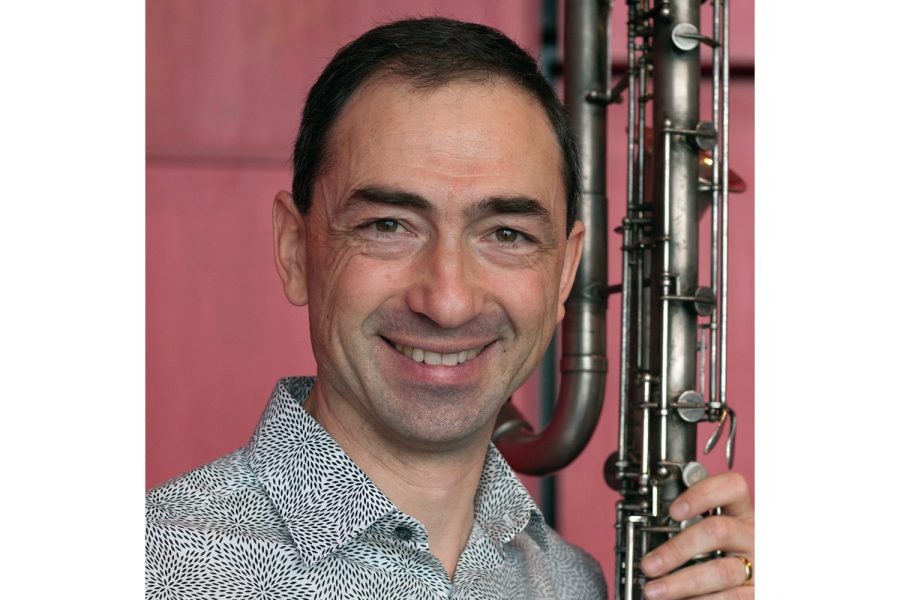UI music professor Jean François Charles: A composer of colorful electrons
University of Iowa professor of composition Jean François Charles creates electronic music in search of exploring new worlds of sounds — he teaches the fundamentals of creating organically produced electronic music with his students.
April 13, 2022
It’s the soundtrack of our lives, but no one’s really listening — a rich landscape of sounds usually left unconsidered has now become a tool for how Jean François Charles creates meaningful works of music.
Charles, an assistant professor in composition and digital arts at the University of Iowa, melds elements of live musicmaking and electronic processes together to create new ideas of sound in his performances.
“For the audience, hopefully it sounds like… the meeting of two worlds,” he said. “Something new out of making two worlds meet.”
For Charles, this meeting not only happens in his music, but also in his discovery of electronic music, and how it has bridged parts of his life together.
Charles, who has an MSc in electrical engineering for applied sciences in Lyon, and a Ph.D. in music and composition from Harvard, is also an accomplished clarinetist. Early on, he never considered combining his interests of electrical engineering and music with the genre of electronic music itself.
“After a while because you meet people and technology is everywhere in music… I started mixing both,” Charles said.
Charles has since gone on to create many works including an opera, Grant Wood in Paris, a part of a trilogy based on American artist Grant Wood, commissioned by the Cedar Rapids Opera House in 2019.
In one aspect of the opera, Charles utilized a renaissance instrument known as a serpent to be both a character and an instrument played in the orchestra pit. He said this instrument embodied the question of sexuality that Grant Wood grappled with during his lifetime.
Charles said he created a rich soundscape and story by including the amplified sound of a pencil touching paper, to recreate how Grant Wood would draw under a table. This signifies how Charles is an exquisite renderer of music in that his music speaks not only to the character but to their environment as well.
“I was asked to write the music and the world,” Charles said.
Charles’ current work, Voltaic, is a piece composed for a viola d’amore, a 14-stringed instrument. The piece also incorporates live electronics for guest violinist Marco Fusi. Charles said he didn’t do anything out of the ordinary for this piece, but just focused on what worked when he was composing.
The concert for the piece will be on April 19 in the Concert Hall of the UI’s Voxman School of Music building.
Charles said that the connection between sounds and exploring these in new and old spaces under the context of the intentions for the music, all play a role. He allows for natural and electronic replications to build off one another — the bridging of two worlds, while savoring the sounds that collide in the “foundational color palette” of sounds set to find one another.
“Why would you create new music?” Charles asked himself. “You want to explore a new sound, you want to create a new musical [space], to explore new musical relations between different sounds.”
This same idea is also prevalent in his teaching, Charles said. He hopes to teach again during the spring 2023 semester with a class that he conceptualized based on creating new musical instruments connected to electronic music processes.
This is done by inserting an electronic chip that responds to electronic processes within students’ newly created instruments. One of his students created a unique guitar pedal that Charles described as “one you won’t find on a shelf.”
In his teaching for this course and other electronic music-based groups, such as the Laptop Orchestra, he said that he ultimately helps students develop an ear for the sounds in electronic music creation. This simple yet integral piece of listening and having intuition for making his electronic music sound organic, is important to how he and others connect colorful electron-produced palettes of sound.
“What’s hard is to get that level of intuition and organicity,” Charles said. “How [should you use] electronic sounds in an organic way, so it sounds as rich and refined as a piece of solo violin?”
Charles said the idea of listening is an equally great tool in two different worlds of composing. When composing with electronic music, Charles said a composer can have the hands-on experience of “touching” the music, because they can immediately listen to what they have created, as opposed to composing on paper. He said he enjoys both forms of composing but finds the electronic relationship between a composer and their music stunningly different.
“[On paper] the performer touches the music, but not the composer,” Charles said. “The composer writes notes on a piece of paper, and then a musician will turn the piece of paper into sound.”
Charles said that with electronic music, a composer such as Charles can experiment more with because they can be more involved in the sound coming off the paper. He discovered how to shape his musical ideas with rich electronic music, describing his world as a “musical soundscape” that he deepens and discovers further by continually melding ideas of sound together.
He began his career in electronic music by bringing together seemingly different elements, and said he plans to continue to do so with colorful electrons that flourish on the edges of new worlds of sound in every piece he creates.














